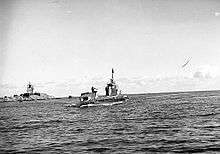Action of 8 June 1945
| Action of 8 June 1945 | |||||||
|---|---|---|---|---|---|---|---|
| Part of the Pacific theatre of the Second World War | |||||||
 Japanese Myōkō-class heavy cruiser Ashigara | |||||||
| |||||||
| Belligerents | |||||||
|
|
| ||||||
| Commanders and leaders | |||||||
|
|
| ||||||
| Strength | |||||||
| 1 submarine |
1 Heavy cruiser 1 Destroyer | ||||||
| Casualties and losses | |||||||
| None |
1 cruiser sunk 1,350 dead | ||||||

The Action of 8 June 1945, sometimes called the Sinking of Ashigara was a naval action that resulted in the sinking of the heavy cruiser Ashigara of the Imperial Japanese Navy by the British Royal Navy submarine HMS Trenchant. Ashigara—which was being escorted by the destroyer Kamikaze—was being used to transport troops from Indonesia for the defence of Singapore and the sinking resulted in a huge loss of life.
Background
Trenchant, under the command of Arthur Hezlet, took up position on the inside of the Bangka Strait while the submarine HMS Stygian watched on the other side. On 8 June 1945, Ashigara left Batavia for Singapore with 1,600 troops on board to reinforce the defence of Singapore.[2] She was escorted by the destroyer Kamikaze which had been present at the Japanese defeat in the Malacca Strait. Blueback reported this movement to Hezlet as he was in a better position and soon patrolled the area.
The action
Kamikaze was patrolling the area and soon a cautious Hezlet spotted the masts of Ashigara nearly 6 mi (5.2 nmi; 9.7 km) away through the periscope at around 11:48. It soon became clear to Hezlet that he could not reach a firing position closer to Ashigara than 4,000 yd (3,700 m), the limit of his torpedoes' range.[3]
At such a distance, Hezlet had to make precise estimable calculations before his chance of an attack disappeared. After 21 minutes, Trenchant fired a full bow salvo of eight torpedoes at about 12:12 at a range of 4,000 yd (3,700 m) aimed individually from a quarter of length ahead to a quarter of a length astern. Because of the shoreline to port Ashigara could only alter toward Trenchant and that meant running into the torpedoes. After three minutes five torpedoes struck Ashigara. Trenchant's company queued to view through the search periscope, but the periscope attracted anti-aircraft fire from Ashigara. Hezlet then turned Trenchant to bring her stern tubes to bear and fired two more torpedoes nearly an hour after first sighting the cruiser. Torpedoes fired by Ashigara at Trenchant's periscope missed, but a fire caused by the first hits had spread rapidly through Ashigara causing a huge pall of smoke to obscure Hezlet's view.[3]
Kamikaze dropped three patterns of depth charges, but these were 3 mi (2.6 nmi; 4.8 km) from Trenchant. Within a few minutes, Ashigara began to capsize rapidly, and Kamikaze immediately returned to pick up survivors.[3]
Aftermath
Losses in the sinking were heavy; out of 1,600 troops, only 400 were saved, whilst the majority of the crew of around 850 were rescued, including Captain Miura. Ashigara was the last remaining major Japanese warship in the area after the cruiser Haguro had been sunk the previous month by British destroyers. After the sinking of Ashigara, the 10th Area Fleet based out of Singapore was left with a solitary destroyer; Kamikaze[4]
The sinking of Ashigara earned Hezlet a bar to his DSO and the U.S. Legion of Merit. HMS Trenchant flew the Jolly Roger as a tribute to her success when she reached her base at Trincomalee. Tactically it was one of the most brilliant submarine attacks of the war in terms of range.[3]
See also
References
Citations
Bibliography
- Compton-Hall, Richard (1965). Submarines at War 1939-45. Periscope Publishing Ltd. ISBN 978-1-904381-22-8.
- D'Albas, Andrieu (1965). Death of a Navy: Japanese Naval Action in World War II. Devin-Adair Pub. ISBN 0-8159-5302-X.
- Dull, Paul S. (1978). A Battle History of the Imperial Japanese Navy, 1941-1945. Naval Institute Press. ISBN 0-87021-097-1.
- Jackson, Ashley; Linton Wells (2006). The British Empire and the Second World War. Hambledon Continuum. ISBN 1-85285-417-0.
- Lacroix, Eric; Linton Wells (1997). Japanese Cruisers of the Pacific War. Naval Institute Press. ISBN 0-87021-311-3.
- Parshall, Jon; Bob Hackett; Sander Kingsepp; Allyn Nevitt. "Imperial Japanese Navy Page (Combinedfleet.com)". Archived from the original on 13 June 2006. Retrieved 2006-06-14.
- Wise, James (2003). Soldiers Lost at Sea: A Chronicle of Troopship Disasters. Naval Institute Press. ISBN 978-1-59114-966-8.